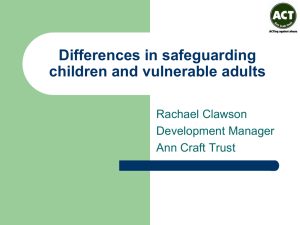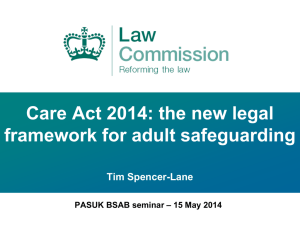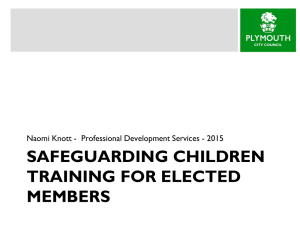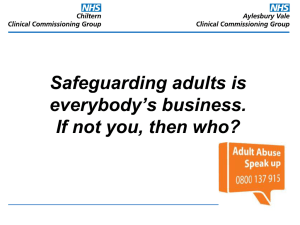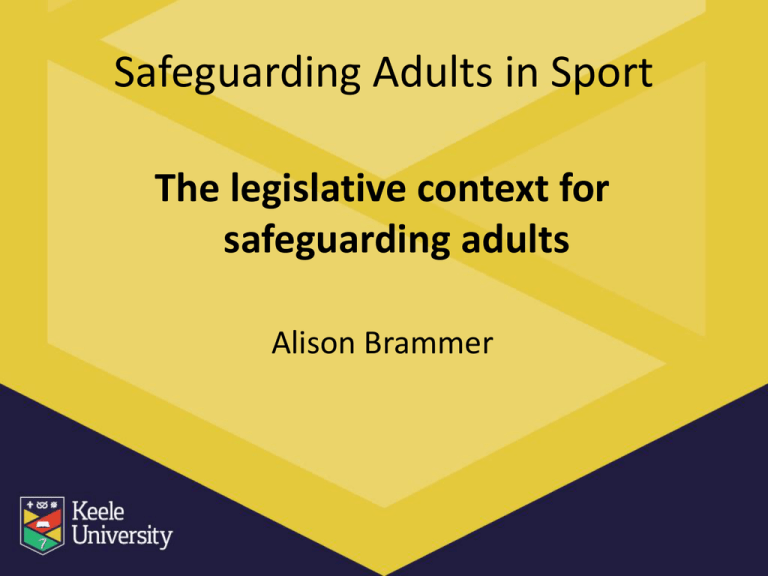
Safeguarding Adults in Sport
The legislative context for
safeguarding adults
Alison Brammer
• Overview of law
• Ensuring good practice within sport
• Taking appropriate action - Recognising and
responding to abuse
The Legal Framework
•
•
•
•
•
No single statute
Complexity of definitions
Developing knowledge base
No specific offence of adult abuse
‘Imaginative’ use of law – depending on type
of abuse, circumstances and location,
objective
‘No Secrets’ (2000)
‘Abuse is a violation of an individual’s human
and civil rights by any other person or persons.
Abuse may consist of a single or repeated acts. It may be
physical, verbal, or psychological, it may be an act of
neglect or an omission to act, or it may occur when a
vulnerable person is persuaded to enter into a
financial or sexual transaction to which s/he has not
consented, or cannot consent. Abuse can occur in any
relationship and ,may result in significant harm to, or
exploitation of, the person.
Categories of Abuse
• Physical, Sexual, Psychological, Financial, Neglect,
Discriminatory
• (Institutional abuse)
• Context and perpetrator – various (No Secrets, 2000)
‘Any or all of these types of abuse may be perpetrated as the
result of deliberate intent, negligence or ignorance’ (2.7)
• ?? Self – neglect, Self-harm, Hate crime, Domestic
abuse, Forced marriage, Medication
Key elements
• ‘agencies primary aim should be to prevent
abuse where possible but, if the preventive
strategy fails, agencies should ensure that
robust procedures are in place for dealing with
incidents of abuse’ (1.2)
• Inter-agency policy
• Principles
• Procedures for responding in individual cases
No Secrets and the law
• Action might be primarily supportive or therapeutic or it might
involve the application of sanctions, suspension, regulatory
activity or criminal prosecution, disciplinary action or deregistration from a professional body. Remember, vulnerable
adults who are victims, like any other victims, have a right to
see justice. (6.4)
• ‘ensure that the law and statutory requirements are known
and used appropriately so that vulnerable adults receive the
protection of the law and access to the judicial process’ (4.3)
Law reform since ‘No Secrets’
Carers and Disabled Children Act 2000
Care Standards Act 2000
Sexual Offences Act 2003
Carers (Equal Opportunities) Act 2004
Freedom of Information Act 2000
Gender Recognition Act 2004
Civil Partnership Act 2004
Domestic Violence Crime and Victims Act 2004
Mental Capacity Act 2005
Safeguarding Vulnerable Groups Act 2006
Mental Health Act 2007
Forced Marriage (Civil Protection) Act 2007
Health & Social Care Act 2008
Equality Act 2010
Legal Knowledge
• Adult social care law -Law Commission 2011
• Safeguarding – Re A [2010] LA responsibilities,
‘In contrast to child care law, adult social
care….has developed piecemeal …it remains a
confusing patchwork of conflicting statutes..it
is characterised by sheer volume of legislation
with much overlap and duplication. It is noted
for its baffling and tortuous complexity …’
Support
• No Secrets – prevention linked to provision of services
• Fair Access to Care Services – critical & substantial level of
need
• Personalisation – personal assistants
• Carers
• Law Commission review
Care and Support Bill
Well-being
Personal budgets
Duty to make enquiries
Statutory safeguarding adults boards
Safeguarding Adults Reviews
Criminal law
• ‘Some instances of abuse will constitute a criminal offence. In
this respect vulnerable adults are entitled to the protection of
law in the same way as any other member of the public.
Examples of actions which may constitute criminal offences
are assault, whether physical or psychological, sexual assault
and rape, theft, fraud or other forms of financial exploitation,
and certain forms of discrimination, whether on racial or
gender grounds…..Criminal investigation by the police takes
priority over all other lines of enquiry.’ (NS 2.8)
Criminal Law
• Sexual Offences Act 2003, Offences Against the
Person Act 1861, Theft Act 1968
• Protection from Harassment Act 1997
• Domestic Violence crime and Victims act 2004
– ‘causing or allowing the death of a child or
vulnerable adult’
• Mental Capacity Act 2005 -Ill treatment and
neglect
Mental Capacity Act 2005
Principles
•
•
•
•
•
Assumed capacity
Practicable steps to assist decision-making
Unwise decisions does not mean incapacity
Best interests (s.4)
Least restrictive option
Capacity issue and time specific
Care or treatment, proportionate restraint
New professional roles and Court of Protection
New mechanisms for delegated decision making
Ill treatment or wilful neglect
Human Rights responsibilities
• Ss 6 & 7 public authority must not act
incompatibly with the Convention articles
• Local authorities, NHS, police, courts, CQC,
Functions of a public nature e.g. independent
hospital, R (A) v Partnerships in Care Ltd [2002]
EWHC 529, Care homes – YL v Birmingham CC [2007]
UKHL 27, Health & Social Care Act 2008
Human Rights Act 1998
• ZH v Commissioner of Police for the Metropolis [2012] EWHC
604 (QB)
• A 16 year old boy with severe autism and epilepsy was taken swimming
and refused to move from the poolside. His carers were unable to move
him with distraction techniques. Police attended and were informed of his
autism. When one of them touched the boy he jumped into the pool. He
was lifted, struggling, out of the pool and the police restrained him to with
handcuffs and leg restraints. He was then placed in a cage in the police
van.
• Human rights claims under articles 3, 5 and 8 were successful. Damages
were awarded. The court noted that, ‘The case highlights the need for
there to be an awareness of the disability of autism within the public
services’.
Standard of Professional practice
‘Duty of Care’
ABB v Milton Keynes Council [2011] EWHC 2745 (QB)
• ‘A social worker’s duty in common with other professionals, is
to exercise reasonable skill and care …..will not be negligent if
she acts in accordance with practice accepted as proper, by a
responsible body of social work opinion, even though another
social worker might adopt a different practice.’
Good Practice
•
•
•
•
•
•
•
Good employment practice
Training and disciplinary procedures
Recruitment strategies – vetting and barring
Safeguarding Vulnerable Groups Act 2006
Clear lines of responsibility
Whistleblowing policies
Human Rights compliant
Recognising and Responding
• Listen to concerns
• Confidentiality
• Make a written record – what was said,
observations, response
• Referral based on most accurate information
available
• Updates and outcomes
Thank you
Alison Brammer
Director: MA Safeguarding Adults: Law, Policy &
Practice
a.k.brammer@keele.ac.uk








